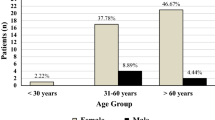Abstract
Yeast microflora was studied in the skin of 91 patients with atopic dermatitis, in bronchial secretion of 13 patients with bronchial asthma and 8 patients with allergic bronchopulmonary mycosis. Forty-eight isolates were obtained. Alypophilic yeast fungi isolated from the skin were presented mainly by generaCandida spp. (48%) andRhodotorula spp. (29%), while the cultures isolated from bronchial secretion mainly byCandida albicans. The sensitivity of yeast cultures to the antifungal drugs diflucan, clotrimazole, nizoral, orungal, exoderil, levorin, pymafuzin, and nitrofungin was determined. The most efficient drugs were diflucan, clotrimazole, nizoral, and orungal. More than half isolates were sensitive only to the high concentrations of levorin (48%), pymafuzin (75%), and nitrofungin (82%); 64% isolates were insensitive even to high concentrations of exoderil. Preliminaryin vitro selection of the antifungal drugs is required for efficient elimination of the yeasts.
Similar content being viewed by others
References
V. G. Arzumanyan, M. A. Mokronosova, and T. L. Samuilova,Zh. Mikrobiol., No. 3, 10–13 (1998).
M. A. Mokronosova, T. L. Samuilova, V. G. Arzumanyan, and V. B. Gervazieva,Ter. Arkh., No. 11, 37–41 (1999).
W. K. Nobl, in:Microbiology of Human Skin [Russian trans lation], Moscow (1986), pp. 83–129.
E. V. Pronina, Z. O. Karaev, and V. P. Alferov,Pediatriya, No. 5, 14–18 (1990).
G. S. De Hoog and J. Guarro, in:Atlas of Clinical Fungi, Amsterdam (1995), pp. 205–238.
A. Espinel-Ingroff, J. L. Rodriguez-Tudela, and J. V. Martinez-Suarez,J. Clin. Microbiol.,33, 3154–3158 (1995).
A. R. Halbert, W. L. Weston, and J. G. Morelli,J. Am. Acad. Dermatol.,33, 1008–1018 (1995).
R. Harley, J. de Louvois, and A. Mulhall, in:The Yeasts, Eds. A. H. Rose and J. S. Harrison, New York (1987), pp. 207–273.
M. A., Morren, B. Przybilla, M. Bamelis,et al., J. Am. Acad. Dermatol.,31, 467–473 (1994).
K. Obtulowicz, B. Pawlik, and P. Gluszko,Allerg. Immunol. (Leipz.), No. 1, 28–34 (1981).
M. A. Pfaller, B. Buschelman, and M. J. Bale,Diagn. Microbiol. Infect. Dis.,19, 9–13 (1994).
S. Ramachandran, A. Shan, K. Pant,et al., Asian Pac. J. Allerg. Immunol., No. 2, 123–126 (1990).
D. Yarrow, in:The Yeasts. A Taxonomic Study, Eds. C. P. Kurtsman and J. W. Fell, Elsevier (1998), pp. 77–100.
Author information
Authors and Affiliations
Additional information
Translated fromByulleten' Eksperimental'noi Biologii i Meditsiny, Vol. 129, No. 6, pp. 704–708, June, 2000
Rights and permissions
About this article
Cite this article
Arzumanyan, V.G., Magarshak, O.O. & Semenov, B.F. Yeast fungi in patients with allergic disease: Species variety and sensitivity to antifungal drugs. Bull Exp Biol Med 129, 601–604 (2000). https://doi.org/10.1007/BF02434889
Received:
Issue Date:
DOI: https://doi.org/10.1007/BF02434889




